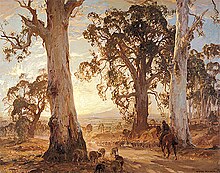Hans Heysen
Hans Heysen | |
|---|---|
 Hans Heysen byHarold Cazneauxca. 1935 | |
| Born | Wilhelm Ernst Hans Franz Heysen 8 October 1877 Hamburg,Germany |
| Died | 2 July 1968(aged 90) |
| Nationality | Australian |
| Known for | Painting |
| Movement | Adelaide Easel Club |
| Patron(s) | H H Wigg, W L Davidson, F A Joyner, Charles Henry de Rose |

statue in Hahndorf byRobert Hannaford

Sir Hans HeysenOBE(8 October 1877 – 2 July 1968) was an Australian artist.
One of Australia's best known landscape painters,[1]Heysen became a household name during his lifetime for his watercolours and oil paintings of theAustralian bush,in particular men and animals toiling among monumentalgum treesagainst a background of atmospheric light.[2]He also won acclaim for his groundbreaking depictions of arid landscapes in theFlinders Ranges.He won theWynne Prizefor landscape painting a record nine times.
Biography
[edit]Wilhelm Ernst Hans Franz Heysenwas born inHamburg,Germany. He migrated toAdelaideinSouth Australiawith his family in 1884 at the age of 7. As a young boy Heysen showed an early interest in art. At 14 he left school to work with a hardware merchant, later taking night classes at the Academy of Arts in Victoria Buildings, Victoria Square, underJames Ashton.He joined theAdelaide Easel Clubin 1897 and was immediately recognised as a rising talent.[3]
At age 20 he was sponsored by a group of wealthy Adelaide art enthusiastsE. S. Wigg,H. H. Wigg and brothers-in-law W. L. Davidson, F. A. Joyner, and miner Charles Henry de Rose, to study art for four years in France.[4]
By 1912 Hans Heysen had earned enough from his art to purchase a property called "The Cedars"35°00′46″S138°48′21″E/ 35.0127°S 138.8057°EnearHahndorfin theAdelaide Hills,which was his home until his death in 1968 aged 90. "The Cedars", named for its massiveHimalayan cedars,has changed little since the 1920s. It remains the property of the Heysen family, but most areas, including Hans's and Nora's studios, are open to the public 10:00 to 16:30 Tuesday to Sunday, and holiday Mondays, except Christmas Day; guided tours 11:00 and 14:00.[5]
Family
[edit]Heysen married Selma "Sallie" Bartels (1878–1962) on 15 December 1904. Her father wasAdolph H. F. Bartels,a formerMayor of Adelaide. Their children were Josephine, Freya, Lilian, Nora, David, Deirdre, Michael, and Stefan.[5]DaughterNora Heysenalso became a successful artist.
Wynne Prize
[edit]Heysen won theWynne Prizenine times, for the following works:
- 1904 –Mystic Morn
- 1909 –Summer(watercolour)
- 1911 –Hauling Timber
- 1920 –Toilers(watercolour)
- 1922 –The Quarry(watercolour)
- 1924 –Afternoon in Autumn(watercolour)
- 1926 –Farmyard, Frosty Morning
- 1931 –Red Gums of the Far North(watercolour)
- 1932 –Brachina Gorge
Recognition
[edit]- In 1937 Heysen became an invited foundation member of, and exhibited, withRobert Menzies' anti-modernist organisation, theAustralian Academy of Art.[6]
- In 1945, he was appointed an Officer of theOrder of the British Empirefor service as trustee of the Hobart National Gallery[7]
- In 1959, he was made aKnight Bachelorfor service to art[8]
- TheHeysen TrailandHeysen Tunnelswere named after Heysen
- TheElectoral district of Heysenin theParliament of South Australiais named after Heysen
See also
[edit]References
[edit]- ^Splatt, William; Burton, Barbara (1977).A Treasury of Australian Landscape Painting.Rigby. p. 45.ISBN9780859020138.Archived fromthe originalon 31 October 2021.Retrieved31 October2021.
- ^Eagle, Jones, Mary, John (1994).A Story of Australian Painting.Australia: MacMillan. p. 112.ISBN0-7329-0778-0.
{{cite book}}:CS1 maint: multiple names: authors list (link) - ^"Fair and Unfair".Quiz and The Lantern.Adelaide: National Library of Australia. 18 November 1897. p. 10.Retrieved22 January2015.
- ^"Hans of Hahndorf".The Mail.Adelaide: National Library of Australia. 3 May 1913. p. 8.Retrieved15 November2014.
- ^abThe Cedars.Hans Heysen Foundation. October 2023.
- ^Australian Academy of Art First Exhibition, April 8th-29th, Sydney: Catalogue(1st ed.). Sydney: Australian Academy of Art. 1938.Retrieved2 November2022.
- ^It's an Honour: OBE
- ^It's an Honour: Knight Bachelor
